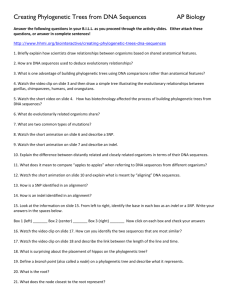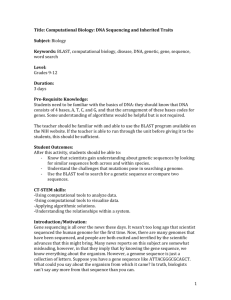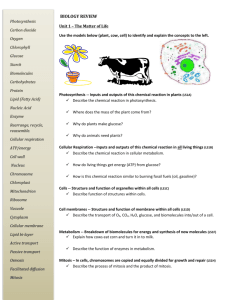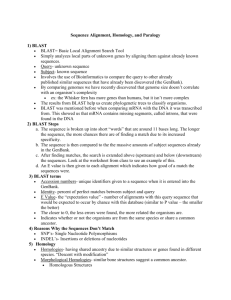Study Guide.Phylogen..
advertisement
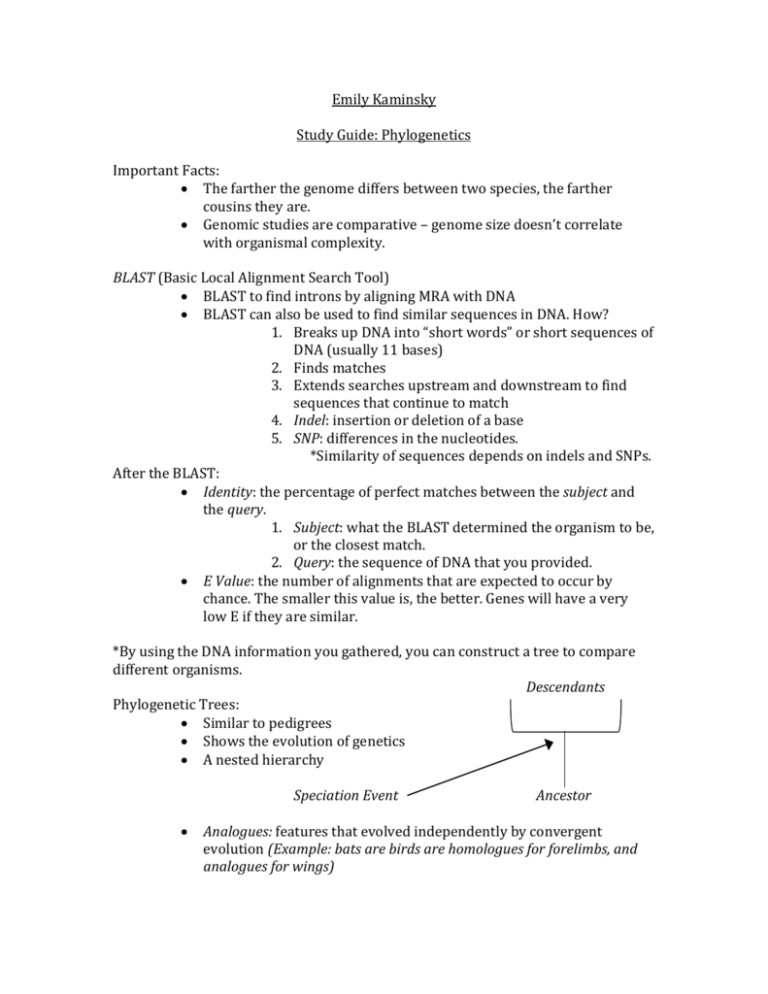
Emily Kaminsky Study Guide: Phylogenetics Important Facts: The farther the genome differs between two species, the farther cousins they are. Genomic studies are comparative – genome size doesn’t correlate with organismal complexity. BLAST (Basic Local Alignment Search Tool) BLAST to find introns by aligning MRA with DNA BLAST can also be used to find similar sequences in DNA. How? 1. Breaks up DNA into “short words” or short sequences of DNA (usually 11 bases) 2. Finds matches 3. Extends searches upstream and downstream to find sequences that continue to match 4. Indel: insertion or deletion of a base 5. SNP: differences in the nucleotides. *Similarity of sequences depends on indels and SNPs. After the BLAST: Identity: the percentage of perfect matches between the subject and the query. 1. Subject: what the BLAST determined the organism to be, or the closest match. 2. Query: the sequence of DNA that you provided. E Value: the number of alignments that are expected to occur by chance. The smaller this value is, the better. Genes will have a very low E if they are similar. *By using the DNA information you gathered, you can construct a tree to compare different organisms. Descendants Phylogenetic Trees: Similar to pedigrees Shows the evolution of genetics A nested hierarchy Speciation Event Ancestor Analogues: features that evolved independently by convergent evolution (Example: bats are birds are homologues for forelimbs, and analogues for wings) Convergent: when groups of organisms develop a trait independently from each other, but both share a common ancestor. Homologues: A gene similar in structure and evolutionary origin to a gene in another species (Example: humerus, radius, and ulna is a trait that is conserved in all tetrapods) 1. Vestigial: a feature that has become functionless throughout evolution. Paralogue: Related genes within a species Clade: a group of organisms, which descend from a common ancestor. 1. Includes ALL descendants 2. If any descendants are excluded, it is not a clade. *Genetic information can also be stored within DNA, but not expressed. (Example: birds contain the genes for teeth, but do not have teeth normally) How to Determine Time: Radiometric dating relies on half-life decay of radioactive elements to allow scientists to date rocks and materials directly. Stratigraphy provides a sequence of events from which relative dates can be extrapolated. Molecular clocks allow scientists to use the amount of genetic divergence between organisms to extrapolate backwards to estimate dates. *When creating a phylogenetic tree, you cannot simply base it on physical appearance. You must take the DNA and genetic codes into account. Even though two organisms may appear to be similar, they may not actually be. (Example: A dolphin is more closely related to a dog than a shark) *If you take into consideration all functions, then an accurate phylogenetic tree can be constructed. Multiple Choice Questions: 1. In order for a branch of a phylogenic tree to be considered a clade, all the descendants must: a. Contain an indel b. Have a high E value c. Share a common ancestor d. Have convergent evolution e. Appear physically similar 2. Which of the following is NOT true about a BLAST? a. It searches for similarities in DNA sequences b. A low E value is more desirable c. Can be used to find introns by aligning MRA and DNA d. It’s main purpose is to find mutations within a single sequence of DNA e. Can be use the results to create a phylogenetic tree 3. What cellular structure is homologous for all eukaryotes? a. Mitochondria b. Vacuole c. Ribosome d. Chloroplasts e. Cytoplasm 4. Which of the following statements is true? a. Phylogenetic trees are based solely on physical appearance b. Genome size directly correlates with complexity of an organism c. Clades do not share a common ancestor d. A ‘snp’ is a similarity in the nucleotides e. Bats and birds are analogous for the wing feature 5. Which of the following would best determine relatedness between organisms? a. Common ancestor b. Compare DNA sequences c. Similar physical appearance d. Compare bone structure e. Compare against different species Essay Questions: 1. Explain the process of comparing two organisms. Include PCR, Sanger sequencing, and BLAST in your response. Start with PCR to amplify a sequence of DNA Use Sanger sequencing to get a barcode which you can read the ATGC nucleotides from BLAST that sequence of DNA Compare the E values and the similarities between your query and other organisms on a database. 2. Define and provide an example of analogues, homologues, and paralogues. Homologues are genes similar to those in another organism. Example: humerus, radius, and ulna appear in all tetrapods. Analogues are traits that develop independently from each other, but result in similar traits. Example: wings in birds and bats Paralogues are a related gene within a species. Example: alpha and beta hemoglobin.
